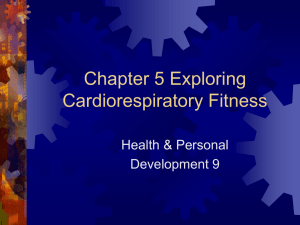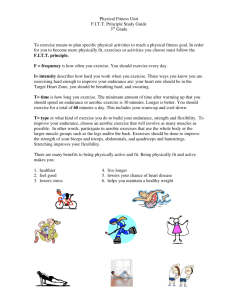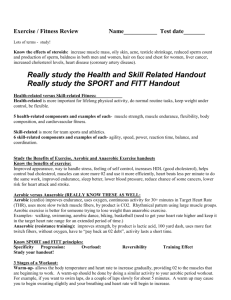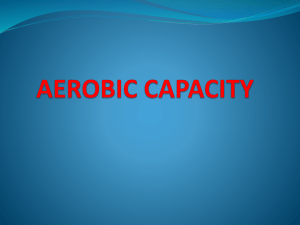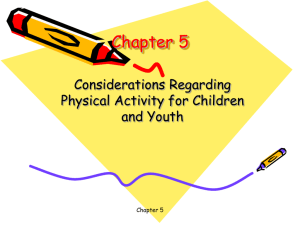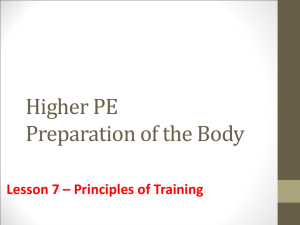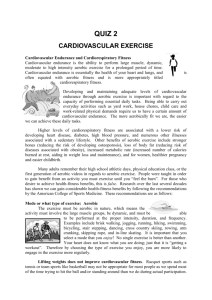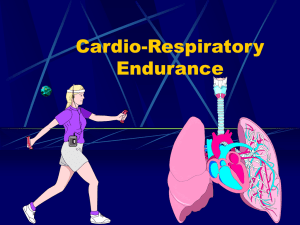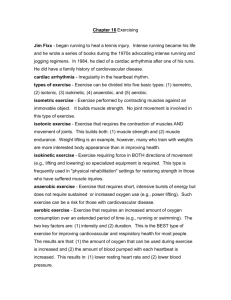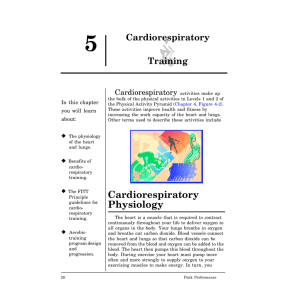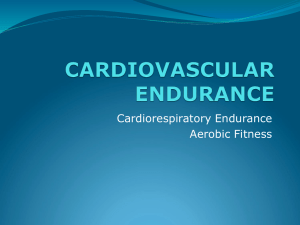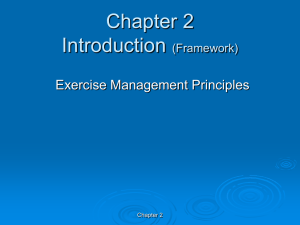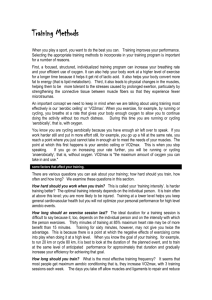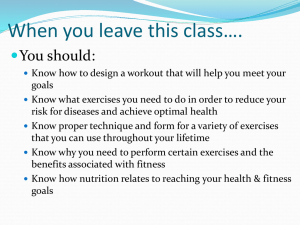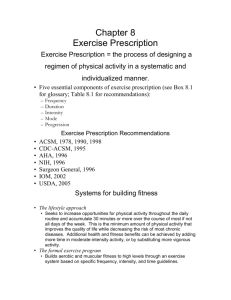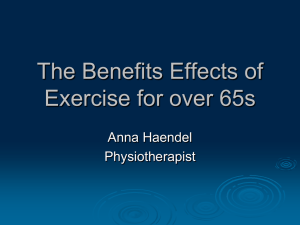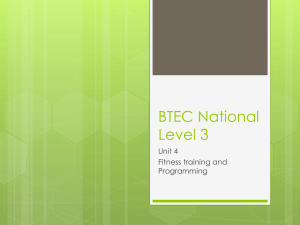Cardiorespiratory Endurance
advertisement
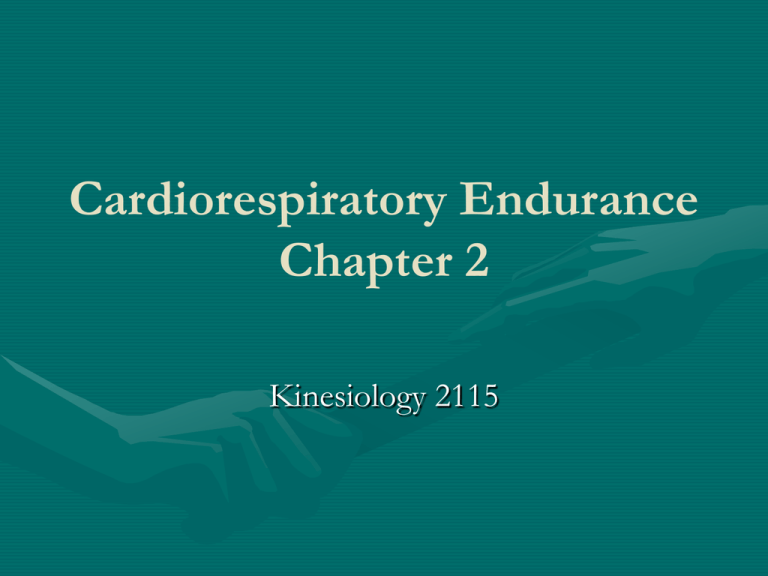
Cardiorespiratory Endurance Chapter 2 Kinesiology 2115 Cardiorespiratory Endurance (also called cardiovascular endurance) • Describes our energy output • Most important component of physical fitness for longevity • Cardiorespiratory endurance is the ability to supply oxygen to working muscles over a period of time Function of the CR System • Four components of the CR System – Heart, blood vessels, blood and lungs • Purpose – Take in and deliver oxygenated blood to the cells of the body – Remove deoxygenated blood and other waste products from the body • Which side of the heart pumps deoxygenated blood to the lungs? – ________ atrium and ventricle • Which side pumps oxygenated blood to the body? – _______ atrium and ventricle Regulation of the CR System • Cardiac Output: the volume of blood pumped per minute – – – – Average adult volume? Stroke Volume: amount of blood pumped per beat CO = dec HR X inc SV When the body exercises, how much blood is pumped per minute? • With improved fitness, cardiac output will increase stroke volume and consequently decrease heart rate • There is a maximum heart rate! – HR max = 220 - age Regulation (Continued) • Maximum cardiac output is effected by maximum Heart rate – HR max decreases with age – What happens to COmax with age? • Blood Pressure is also a factor – Blood pressure: the force of blood against vessel walls – Arterial (contraction) pressure is the systolic pressure – Pressure when the heart relaxes (between beats) is the diastolic pressure – Normal BP? – Borderline hypertensive? Energy Systems • Metabolism – – – – – ATP (Adenosine Triphosphate) ATP-PC system 1- 10 seconds Anaerobic system 10 seconds-3 minutes Aerobic system >3 minutes Most activities combine anaerobic and aerobic systems • Maximal Oxygen Consumption (VO2 max) – Ability to utilize oxygen while working and removing CO2 Energy Systems (Continued) • VO2 max is one of the best measures of cardiorespiratory endurance – The higher your VO2 max, the more you can delay fatigue-oxygen debt – (This means you’re more fit) – You can recover from oxygen debt more quickly – Can be measured in the lab or a field test (examples of lab test: treadmill or stationary bike) Testing VO2 Max Physiological Benefits of CR Endurance • • • • • • • • • Greater CO: more blood, faster Longevity Improved VO2 max: produce more ATP Lowered blood pressure Reduced body fat, firm muscles Increased metabolism, remains elevated after exercise Increase HDL cholesterol, lower LDL Less bone mineral loss Curbing of appetite Acute/Chronic Changes with Aerobic (Cardio) Exercise • Acute – – – – – Increased metabolism Increase CO Systolic blood pressure Ventilation (respiratory rate) Muscle hypertrophy resulting in the slowing of digestion All return to normal quickly after exercise ends • Chronic – Increased metabolism due to increase in lean muscle mass – Lower resting HR – Increased SV – Increased cellular activity – Increased capillarization of muscle – Improved oxygen utilization, muscle glycogen Must maintain over a lifespan or changes will revert back Aerobic Exercise Plan Considerations • • • • • • Precautions Objectives Assess current fitness level Mode Selection Safety Concerns Staying Motivated Mode of Exercise • Warm-up – 5-10 minutes LIGHT cardio followed by LIGHT stretching • Activity Period – Overload principle – Intensity (how hard) • Rate of Perceived Exertion (RPE) or • Target Heart Rate range – [(220-age) – RHR] x % intensity range + RHR – % intensity range dependant upon current health status – Duration (how long) – Frequency (how often) • Cool-down – LIGHT cardio and stretching Types of Aerobic Exercise High Aerobic Potential Moderate Aerobic Potential Low Aerobic Potential Aerobic dance Basketball Archery Aerobic walking Calisthenics Baseball Bicycling Downhill skiing Bowling Cross-Country skiing Field hockey Football Hiking uphill Handball Golf Jogging Racquetball Softball Rope jumping Soccer Volleyball Rowing Squash Running Tennis (singles) Stair climbing Swimming Implementing a Program • • • • Evaluate initial fitness level Schedule exercise as a part of your day Find a variety of modes Keep in target heart rate zone – Increase duration and frequency before intensity • Be aware of overtraining – Start between 500-2000 calories per week • You don’t want to lose more than 2 lbs per week • 3500 calories = 1 lb Benefit to Risk Ratio • Health Risks (Consult a physician) • Sudden illness, hidden heart problems • Stop exercising and contact MD if: – Pain in the chest, under sternum, or radiating to the arm; also, any other unexplained pain – Irregular pulse rate (flutters or rapid rate changes) – Palpitations in the chest or throat – Dizziness, lightheadedness, confusion or fainting Note: Anything out of the ordinary, even if you are in shape Other Health Considerations • Muscle soreness and injuries – Delayed onset muscle soreness is normal - 24-48 hours later – If it persists, the muscles have been worked too hard • Basic musculoskeletal injuries – – – – Rest Ice Compression Elevation • Most exercise injuries are caused by poor warm-up, mechanics, equipment, increasing intensity or duration too quickly Preventing Injuries • • • • Warm-up thoroughly Gradual progression Listen to your body – RICE and ibuprofen Avoid poor biomechanical situations – – – – Running in one direction Running on slanted roads, downhill Poor shoes Avoid hard surfaces • Substitute with lower impact exercises – Machines (elliptical, stationary bike), swimming, walking Heat Illnesses • Check temperature and humidity – Adjust duration and intensity – Exercise during cool times, in the shade and wear loose clothing • • • • Drink before, during and after exercise Replenish electrolytes (salt, potassium) Sedentary, overweight, older at greater risk Acclimatize
